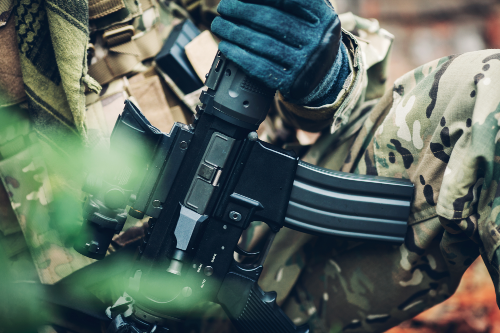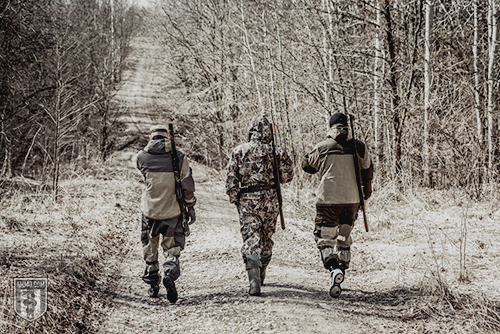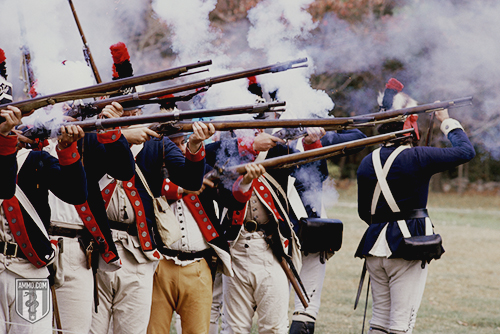This report was originally published at Ammo.com

“It is interesting to hear certain kinds of people insist that the citizen cannot fight the government. This would have been news to the men of Lexington and Concord, as well as the Mujahedeen in Afghanistan. The citizen most certainly can fight the government, and usually wins when he tries. Organized national armies are useful primarily for fighting against other organized national armies. When they try to fight against the people, they find themselves at a very serious disadvantage. If you will just look around at the state of the world today, you will see that the guerillero has the upper hand. Irregulars usually defeat regulars, providing they have the will. Such fighting is horrible to contemplate, but will continue to dominate brute strength.” – Col. Jeff Cooper
When one discusses the real reason for the Second Amendment – the right of citizens to defend themselves against a potentially tyrannical government – inevitably someone points out the stark difference in firepower between a guerilla uprising in the United States and the United States government itself.
This is not a trivial observation. The U.S. government spends more on the military than the governments of China, Russia, Saudi Arabia, India, France, United Kingdom, and Japan combined. Plus, the potential of a tyrannical government is arguably upon us – with the federal government spying on its own citizens, militarizing local police departments with equipment and tactics from the War on Terror, and repeatedly searching Americans, which desensitizes them to this invasive process.
There is much historical precedent, however, for guerilla uprisings defeating more powerful enemies. For instance, the Cold War saw both superpowers brought to their knees by rural farmers – for the Soviets, their adventure in Afghanistan against the Mujahideen, and for the United States, the Vietnam War against the Viet Cong.
In both cases, nuclear weapons could have been used against the guerilla uprising, but were not. Even assuming the use of nuclear weapons from the position of total desperation, it’s hard to imagine they would have made much of a difference in the final outcome of either conflict. Unlike the invading armies, the local resistance enjoyed both broad-based support as well as knowledge of the local terrain.

Now imagine such a scenario in the United States. You wouldn’t be the first person to do so. From Red Dawn to James Wesley, Rawles’ Patriots series, there is a relatively long-standing tradition of American survival literature about the hoi polloi resisting the tyranny of big government, either before or after a collapse.
For the purposes of this article, consider what a domestic American terrorist or freedom fighter (after all, the label is in the eye of the beholder) organization based on the militia movement would look like in open revolt against the United States government. In the spirit of levity, we’ll call them the “Hillbilly Viet Cong.” They would most likely find their largest numbers in Appalachia, but don’t discount their power in the American Redoubt, or the more sparsely populated areas of the American Southwest, including rural Texas.
Here we have tens of thousands of Americans armed to the teeth with combat experience, deep family ties to both the police and the military, extensive knowledge of the local geography, and, in many cases, survivalist training. Even where they are not trained, militant and active, they enjoy broad support among those who own a lot of guns and grow a lot of food.
On the other side, you have the unwieldy Baby Huey of the rump U.S. government’s military, with some snarky BuzzFeed editorials serving as propaganda.
Could the Hillbilly Viet Cong take down the USG? Maybe, maybe not. But it’s difficult to imagine that the USG could take them down.
Indeed, even with a number of nasty little toys on the side of the federal government, we live in an age of a technologically leveled playing field. This is true even when it comes to instruments of warfare. While the USG has nuclear weapons, it’s worth remembering that a pound of C4 strapped to a cheap and readily available commercial-grade drone is going to break a lot of dishes.
This sort of guerilla insurgency has a name: It’s called fourth-generational warfare (4GW), and you might be surprised to learn that you already live in this world.
What Are the First Three Generations of Warfare?

To understand how 4GW is a new and improved form of war, we first need to explain what the first three generations of warfare were:
First-Generation Warfare
The first generation (1GW) is basically what you would have seen in the movie 300. The hallmarks of this generation of warfare are armies from two different state actors leveraging line-and-column tactics and wearing uniforms to distinguish between themselves.
This generation is not entirely without subterfuge. For example, counterfeit currency was used to devalue the money supply during the 1GW Napoleonic Wars. Other examples of 1GW conflicts include the English Civil War and the American Revolutionary War.
Second-Generation Warfare
The second generation (2GW) comes with the advent of rifling and breech-loaded weapons. As students of military history know, the invention of rifling was one of the reasons that the United States Civil War was so bloody. This meant that firearms that were once mostly for show after 100 feet or so, were now deadly weapons – and tactics did not immediately evolve.
But evolve they did. Many things we take for granted as being just part of warfare – such as camouflage, artillery, and reconnaissance – are defining features of 2GW. The American Civil War is probably the first 2GW conflict. Others include the First World War, the Spanish Civil War and, much more recently, the Iran-Iraq War. The United States military coined this phrase in 1989.
Third-Generation Warfare
This phase of warfare, also known a 3GW, is the late modern version of warfare, where speed and stealth play a much bigger role. Weapons and tactics alone are less important. Instead, military units seek to find ways to outmaneuver one another before – or even instead of – meeting on the battlefield.
The era of 3GW was initiated with the Blitzkrieg, which marked the decisive end to cavalry and replaced it with tank and helicopter warfare. Junior officers were given more leeway to give orders. The Second World War was the first 3GW conflict, with the Korean, Vietnam and both Iraq Wars becoming further examples of this style of fighting.
What Is Fourth-Generation Warfare?

The most direct way of discussing 4GW is to say that it describes any war between a state actor and a non-state actor. This is also known as asymmetrical warfare, but it’s not the only difference between 4GW and other, earlier forms of conflict. Asymmetrical warfare does, to be sure, blur the lines between combatants and civilians. This is in part what made the Bush-era “war on terror” so difficult and complicated: The war was against a set of ideas rather than a nation or even an extra-national army.
There are a number of characteristics that flow from the state actor vs. non-state actor aspect of 4GW. The first is the use of terrorism as a regular tactic, almost always on the part of the non-state actor. Particularly for the state actor, non-combatants become tactical problems – you simply can’t just carpet bomb and hope everything works out.
The non-state actors tend to be highly decentralized. One faction can stop fighting as another 10 crop up in its place. Funding and source of manpower and material comes from a wide array of sources spread out over nearly the entire globe. This necessarily makes 4GW long and drawn out over years or perhaps even decades. The psychological warfare, propaganda and lawfare aspects are an integral part of the conflict.
The genesis of 4GW lies in the Cold War and the post-colonial era. Insurgent groups and counter-insurgency groups vied for power, often times with state actors operating behind the scenes and in the background. Sometimes the goal was to establish a new state or reestablish a defunct one. However, many times the only goal was to delegitimize the existing state and create a power vacuum.
Places such as Laos, Myanmar, Iran, Guatemala, Vietnam, the Congo, Cuba, East Timor, Korea, Poland, and Afghanistan were all pieces in the global chessboard of the Cold War as various insurgency and counter-insurgency groups backed by the Soviets, the Americans, and/or the Chinese fought one another or fought against occupying forces.
What Is the Difference Between 4GW and Asymmetrical Warfare?
Put simply, all 4GW is asymmetrical, but not all asymmetrical warfare is 4GW. It refers to virtually any asymmetry in combat. This can be as simple as one military having more advanced technology than another – for example, the English longbow at the Battle of Crécy gave the English forces a decisive technological advantage. The Spartan forces were greatly outnumbered by their Persian adversaries and used the landscape to compensate.
In one sense, 4GW can be seen as asymmetric warfare come to full fruition. The less powerful forces must find a way to compensate for their relative lack of strength. On the other hand, the stronger forces must paradoxically find ways to compensate for their abundance of strength. This is because of the all-important propaganda war, an integral part of 4GW. State actors often seek deniability during war by proxy when engaging non-state actors.
John Boyd, Chuck Spinney, and 4GW
Colonel John Boyd may be the most remarkable unsung hero in all of American military history. Widely considered to be the greatest U.S. fighter pilot ever, Boyd developed the F-15 and F-16, revolutionized ground tactics in war, and covertly designed the coalition battle plans for the 1990-91 Gulf War. He foresaw 4GW, and he shunned wealth, fame, and power in his pursuit to get things done, despite the bureaucracy of the Pentagon.
Boyd closely studied Sun-Tzu (The Art of War) and Carl von Clausewitz (On War). This informed his push for greater adaptability and agility of United States fighting forces. Simple, cheap, effective, dependable, durable weapons were prized over flashy tricks. Decentralized command, control and communications were Boyd’s cause – looking for a way to avoid burying boots on the ground underneath layers of officers with potentially less field knowledge than they had.
Franklin C. “Chuck” Spinney became the voice of 4GW preparation after Boyd’s passing inside the Pentagon. He spent more than 20 years campaigning against rigid forms of thinking and budget bloat. Spinney believes that the 9/11 attacks should have been a wake-up call for the United States military, and sees 4GW as something beyond mere terrorism, but rather a new form of warfare. He believes the United States military is stuck in second-generation warfare thinking and is woefully unequipped for 4GW. Ultimately, Spinney believes that the United States military’s response to 9/11 in particular and 4GW in general was not enough.
Where Is 4GW Happening Today?
While many think 4GW is something in the far-off future, it’s actually happening right now. The most archetypal 4GW is perhaps the conflict with ISIS – a non-state actor with recruits all over the world in conflict with several states. Some of the conflict is classically military, but there is also the propaganda war taking place all over the Internet. In fact, ISIS was using the PlayStation network to communicate because they correctly believed it wasn’t being monitored by international intelligence services. These attacks on the West were not limited to the area controlled by ISIS, but extended all around the world.
Counter-attacking ISIS was a bit like trying to catch water in a net. Attacking ISIS proper was possible: There was territory. But attacking the support of ISIS was a whole other problem.
It’s worth noting that the international Islamist movement is not limited to ISIS. Al-Qaeda and its offshoots still exist. What’s more, they seem to multiply over time. This is another feature of 4GW. A state actor can make peace with one faction of a group while other, more militant factions simply retreat deeper into the metaphorical mountains to continue the fight – which is precisely the situation that the Republic of the Philippines has faced in its struggle against the Moros separatists of the Southern Philippines.
But the Philippines and Syria are all likely far away from where you live in terms of geography, sociology, demographics and culture. What does 4GW have to do with London, Paris or even Springfield, MO? Probably a lot more than you think.
Is 4GW Coming to the Developed World?
Is fourth-generational warfare coming to the developed world? Quite possibly, especially when you consider the spectre of failed states in the West.
Many Western states are not quite as stable as they are made out to be. Sweden and France in particular have extensive problems with No Go Zones. Other parts of Europe want to secede, such as Catalonia in Spain, and are being violently suppressed from doing so.
Elsewhere around the world, previously first-world countries like South Africa are deteriorating in the span of a generation due to government mismanagement. The United States, for its part, is in what some have described as a “Cold Civil War,” with many futurists agreeing that the potential for outward civil war is greater than you’d like to think.
How might such a 4GW scenario play out in the West? There are two potential scenarios, one for Europe and one for the United States. Each of these is worth considering.
4GW: The European Model
For our purposes, we’re going to call this the “European Model” of 4GW. This is because this model is based on the political and social realities of life in Europe today. It is by no means the only place something like this could unfold, nor is it impossible that 4GW could unfold in an entirely different way in Europe.
4GW in Europe will likely be an outgrowth of No Go Zones and resulting failed states. Geographic areas within European nations will likely increase in size. And conflict will likely develop between the de facto areas of the No Go Zones, as well as more militant elements of the civilian population. While there is not much of a militia movement to speak of in Europe, in true 4GW fashion, people will find ways to improvise weapons out of what they have available to them.
It’s impossible to talk about this phenomenon in Europe without discussing the ethnic and religious character of the areas, as ethnic and ethno-religious conflict will likely be the infrastructure for such a war – especially since many of these areas have legal and social structures based on Islamic laws and customs.
In a scenario leading to a 4GW conflict in mainland Europe, attacks on civilians will escalate while the legitimate civilian authority is increasingly incapable of dealing with it. There will be both an inability and an unwillingness to maintain legal norms within larger and larger areas in Europe.
Next would come the formation of militias. The model here is close to what happened in Lebanon during its civil war. Militias will form around political, ethnic and religious lines. Some of these will be the No Go Zones attempting to consolidate their power. Others will be European civilians seeking to protect themselves and their neighborhoods from the growing power of the No Go Zones. This, in turn, will further fuel the breakdown in government control. Members of the government, both law enforcement and military, will increasingly pick sides in the conflict, leaving their allegiance to the rump state behind. In the end, this will make it more difficult for the state to assert its power.
The remaining government will begin taking measures against free speech and free association in an attempt to crack down and regain lost power. But at this point, the battle will mostly already be lost. Factions of the government will cease cooperating with one another, making it harder and harder to maintain order. These factions will, to varying degrees, start lining up behind the militias and parallel legal structures that have begun cropping up at the street level. This will also be the time foreign governments will step in and begin supporting local militias more. An example of this is Serbian-backed militias in Croatia and Bosnia during the Yugoslav Wars, or Israeli support of Maronite Christians and Iranian support of Shiite Muslims during the Lebanese Civil War.
Crime will increase, but not just petty street crime. Insurgent movements have a long history of using organized crime to fund their operations and the 4GW conflicts in Europe would be no exception to this. The drug trade, human trafficking and financially driven kidnapping are three examples of how militias will fund themselves using extra-legal means. This will serve as an additional cause to restrict freedom of movement through both de jure and de facto means within a nation’s borders, another case where the Yugoslav Wars and Lebanese Civil War are instructive cases. Conversely, refugee scenarios will develop, which will further complicate the situation.
4GW: The American Model
The American 4GW Model is somewhat different and is based more on ideological and political differences than ethnic and cultural ones – though the ethnic and cultural differences will play a role, as we will soon see.
In the United States, the federal system of government can play a key role. For example, while the prospect of a gun ban causing the peasants to pick up their pitchforks and torches is unlikely, a scenario where states simply refuse to enforce the law is far closer to the realm of possibility. Consider that this is already starting under the Trump Administration – cities and states are refusing to comply with the President’s directives on federal immigration law. Flipping the script, it’s worth wondering just how much state and federal compliance a federal ban on AR-15s, a high tax on ammunition, or a call for widespread registration would generate.
This could happen one of two ways: Leftist states like California and Massachusetts balk at a new federal law, or more conservative and libertarian states like Arizona and New Hampshire refuse compliance. It’s worth noting that states themselves are not monoliths. California is largely still a conservative state outside of Los Angeles and the Bay Area, while several municipalities in deep blue Massachusetts went for Trump. On the other hand, Arizona has blue enclaves like Flagstaff and New Hampshire’s cities vote almost identically to Boston.
The red state / blue state divide is very real, but it also exists within states as well as between them. In the event that a cleavage between the two political and cultural halves of America started, this divide would become increasingly unstable within the states themselves.
Unlike Europe, the United States has a homegrown militia movement that is heavily armed and, to varying degrees, ready for battle. When the AR-15 is talked about as a “weapon of war on our streets,” it is frequently mentioned in the same breath how an insurrection in the United States would never stand a chance against the modern weapons of war wielded by the federal government. This would be news to the Viet Cong. People who make such statements are unaware of the dynamics of 4GW.
While the political aspects are very real, so are the demographic ones. In particular, there is the spectre of the Scotch-Irish in Appalachia. These are a people with hundreds of years of long skepticism (and often outright hostility) toward the federal government. It’s also, geographically speaking, a very difficult place to conquer. Eric Rudolph evaded the feds for five years in the mountains of North Carolina, despite being on the FBI’s Ten Most Wanted Fugitive List.
This segment of American society has a significant connection to both the police force and the military. Simple suggestions that local police, SWAT teams or even the military will be quick to crush such a rebellion are ill-informed on two counts. First, the aforementioned one: In many cases, the military and police who are being sent out are going to be friends, family and intimates of the Hillbilly Viet Cong. What’s more, due to the extensive military experience in this area, many of the foot soldiers of an anti-government rebellion centered in Appalachia would not only just be trained, but also battle-tested. Divided loyalties always play a role in 4GW, and the United States will be no exception.
The weapons of war are leveled in 4GW. There is air war by drones, but also the role of computer hacking, kidnapping and other unsavory activities. The point of 4GW, from the perspective of the underdog, is less about “winning” in some quick and dramatic fashion, and more about dragging out the conflict as long as possible, causing the dominant power to lose through blood loss and death by 1,000 cuts.
Consider the Vietnam Conflict: Between the end of the French occupation of Vietnam in 1954, through the Fall of Saigon when U.S. forces abandoned the city to the Viet Cong, the American Vietnam War lasted approximately 20 years. And that doesn’t count the seven bloody years of French occupation post-WW2, when French colonial forces lost approximately 100,000 troops attempting to put down the guerilla movement in Indochina.
Finally, there’s the U.S. government’s track record in 4GW. The United States does not have a solid track record of being able to defeat guerilla insurgencies. From the Filipino Insurrection in the late 19th century to the current Afghan insurgency – the United States military can make inroads against 4GW actors, but it’s never really able to seal the deal.
4GW in America: The Battle of Athens
There is a history of 4GW in the United States and we don’t need to go very far back to find it. In 1946, there was an uprising of the citizens of Athens, TN (in McMinn County) to reestablish the rule of law. The story illustrates how American patriots resisting domestic tyranny can succeed in their struggles.
Citizens of Athens had complained about election fraud since 1940. The town was filled with battle-hardened veterans from both the European and Pacific theaters of World War II. This filled them with a militancy that did not exist before the war. Several citizens of Athens had complained, but the administration of Franklin Roosevelt did nothing, perhaps because the town was ruled over by an entrenched Democratic Party machine.
First, the men ran one of their own, a GI named Knox Henry, for sheriff. They wanted fair elections, so they petitioned the FBI to monitor, a request which was denied. The machine, for their part, imported 200 strong arms to “protect” the polling places from voters. In one case, a deputy pointed his revolver at a GI, ejecting him from the polling station and telling him “If you sons of bitches cross this street I’ll kill you!” Poll watchers were arrested and in one case, a black poll watcher was shot. Finally, the party machine locked the ballot boxes up in the county jail.
Despite lacking in numbers, ammunition and arms, the veterans used the key to the local armories belonging to the State and National Guard. This evened the score considerably. They went to the jail house and requested the release of the ballot boxes, but were rebuffed with the sheriff’s men shooting two of the GIs. A firefight erupted and the GIs were reinforced by men from neighboring Meigs County and their IEDs. Eventually, the sheriff and his men surrendered, releasing the ballots.
After obtaining the ballots, the men cleaned and returned the weapons. The GI candidate was elected sheriff and several others were elected to key county positions.
This demonstrates 4GW in miniature in the United States. For those concerned about nuclear retaliation or other heavy guns the USG has, it’s worth noting that the underdog can always obtain some of these weapons by hook or by crook.
The Militia Movement and 4GW
No discussion of 4GW in the United States would be complete without touching on the militia movement, something specific to the U.S. While Europe has a history of factions in the military who oppose the government (the French Secret Army Organization is the most famous of these), it does not, to nearly the same extent as the United States, have men actively training in the woods getting ready for civilizational collapse or 4GW.
The militia movement began in the early 1980s, when it was known as the Posse Comitatus movement. It exploded (no pun intended) after the attack on the Oklahoma City Federal Building and the showdown at Ruby Ridge. By the mid-1990s, the militia movement had a presence in all 50 states and was comprised of approximately 60,000 people.
Note that the militia movement is no longer limited to the political right. Left-wing organizations have begun openly training with arms since the election of Donald Trump as President in 2016. In any kind of 4GW scenario in the United States, it’s likely that these two strains of the militia movement would come into conflict with each other, as well as the United States government. And don’t forget about the narcissism of small differences that tends to plague fringe political movements – the most bitter enemies in a 4GW conflict in the United States will likely be competing factions of left- and right-wing political movements.
Skills Required for 4GW
Combat isn’t the only helpful skill for 4GW. If you’re concerned with 4GW and want to get ready for everything to go down, here’s a list of skills for you to acquire in preparation for 4GW.
- Weapons Versatility: Let’s just get this out of the way. Combat training with a variety of weapons is important for 4GW. This is because in 4GW, combatants often have to use weapons commandeered from their enemies. What they capture can vary widely from what their unit ordinarily uses.
- Survivalism: Knowing how to live off the land is an indispensable skill for any SHTF scenario, and 4GW is no exception to this rule. 4GW combatants must know how to hunt, fish, trap, track, stay hidden, find potable water, and prep game.
- First Aid: Any time there’s combat, there are casualties. 4GW requires the knowledge of first aid at the very least. Knowing other medic skills is a welcome addition to the toolkit as well.
- Physical Fitness: Those involved in 4GW combat will have to walk long distances, often with a lot of weight strapped to their back. Being in top physical condition can mean the difference between life and death.
- Navigation: 4GW combatants need to know the area, but they also need to know how to find their way around unfamiliar terrain. That means without electronic equipment, and instead using items like compasses and maps.
- Demolition: This might also be filed under weapon versatility. Demolition is a big part of 4GW for depriving the enemy of a base and cutting off lines of communication and transit.
Many of the above skills are just as helpful when it comes to general survivalism, so you don’t have to be getting ready for 4GW to make them worth acquiring. And as with any kind of SHTF preparation and training, we hope you never have to use what you learn.










0 Comments